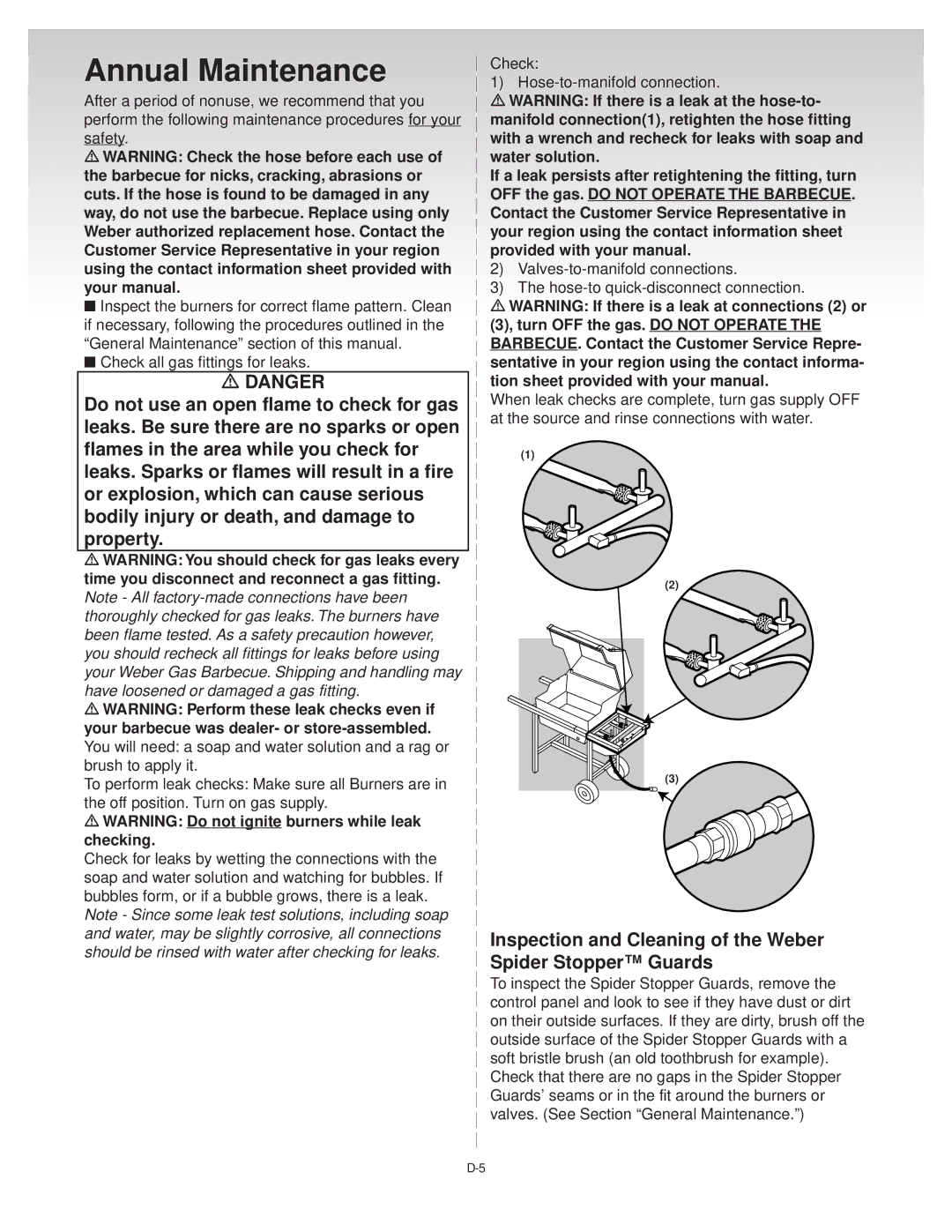
Annual Maintenance | Check: |
1) | |
After a period of nonuse, we recommend that you | m WARNING: If there is a leak at the |
perform the following maintenance procedures for your | manifold connection(1), retighten the hose fitting |
safety. | with a wrench and recheck for leaks with soap and |
m WARNING: Check the hose before each use of | water solution. |
the barbecue for nicks, cracking, abrasions or | If a leak persists after retightening the fitting, turn |
cuts. If the hose is found to be damaged in any | OFF the gas. DO NOT OPERATE THE BARBECUE. |
way, do not use the barbecue. Replace using only | Contact the Customer Service Representative in |
Weber authorized replacement hose. Contact the | your region using the contact information sheet |
Customer Service Representative in your region | provided with your manual. |
using the contact information sheet provided with | 2) |
your manual. | 3) The |
■ Inspect the burners for correct flame pattern. Clean | m WARNING: If there is a leak at connections (2) or |
if necessary, following the procedures outlined in the | (3), turn OFF the gas. DO NOT OPERATE THE |
“General Maintenance” section of this manual. | BARBECUE. Contact the Customer Service Repre- |
■ Check all gas fittings for leaks. | sentative in your region using the contact informa- |
m DANGER | tion sheet provided with your manual. |
Do not use an open flame to check for gas | When leak checks are complete, turn gas supply OFF |
leaks. Be sure there are no sparks or open | at the source and rinse connections with water. |
| |
flames in the area while you check for | (1) |
leaks. Sparks or flames will result in a fire |
|
or explosion, which can cause serious |
|
bodily injury or death, and damage to |
|
property. |
|
m WARNING: You should check for gas leaks every |
|
time you disconnect and reconnect a gas fitting. | (2) | |
Note - All | ||
| ||
thoroughly checked for gas leaks. The burners have |
| |
been flame tested. As a safety precaution however, |
| |
you should recheck all fittings for leaks before using |
| |
your Weber Gas Barbecue. Shipping and handling may |
| |
have loosened or damaged a gas fitting. |
| |
m WARNING: Perform these leak checks even if |
| |
your barbecue was dealer- or |
| |
You will need: a soap and water solution and a rag or |
| |
brush to apply it. | (3) | |
To perform leak checks: Make sure all Burners are in | ||
| ||
the off position. Turn on gas supply. |
|
mWARNING: Do not ignite burners while leak checking.
Check for leaks by wetting the connections with the soap and water solution and watching for bubbles. If bubbles form, or if a bubble grows, there is a leak.
Note - Since some leak test solutions, including soap
and water, may be slightly corrosive, all connections |
| Inspection and Cleaning of the Weber |
| ||
should be rinsed with water after checking for leaks. |
| Spider Stopper™ Guards |
| ||
|
| |
|
| To inspect the Spider Stopper Guards, remove the |
|
| |
|
| control panel and look to see if they have dust or dirt |
|
| |
|
| on their outside surfaces. If they are dirty, brush off the |
|
| outside surface of the Spider Stopper Guards with a |
|
| |
|
| soft bristle brush (an old toothbrush for example). |
|
| |
|
| Check that there are no gaps in the Spider Stopper |
|
| |
|
| Guards’ seams or in the fit around the burners or |
|
| |
|
| valves. (See Section “General Maintenance.”) |
|
| |
|
|
|
